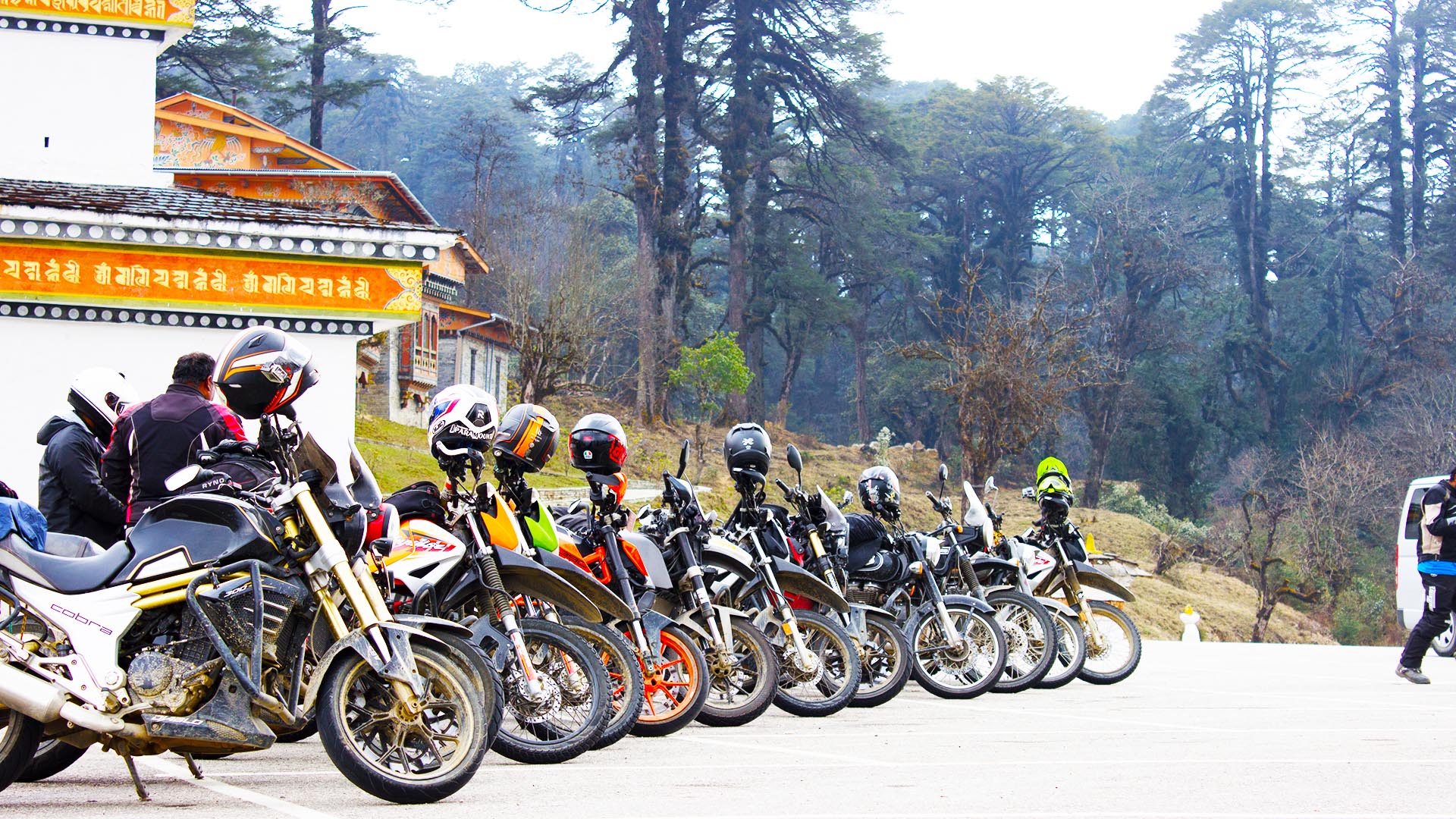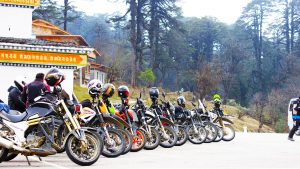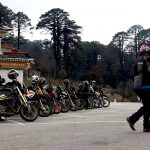
Biking tour and itinerary
10 Night 11 Day Biking tour itinerary
- Day 1:
- Arrive Paro
Fly into Paro from by Drukair (Royal Bhutan Airlines) or by Bhutan Airlines (Private Tashi Air). The great snow-capped peaks of the inner Himalayas rise up to the heavens can be seen during clear weather. As the plane approaches Bhutan, if you look down farmhouses as dots on the hillsides can be seen.
After immigration and customs formalities, you will be received by our representative and driven to your hotel.
After checking into your hotel and refreshment /lunch visit the following:
Rinpung Dzong, built in 1645 to defend the valley against Tibetan invaders. The Dzong is now being used as an administration center and school for monks.Then walk down to Rimpung Bridge (Traditonal Bridge), oldest bridge in Bhutan.
Kichu temple,one of the 108 temples built in the 7th century by the Tibetan King Songsten Gampo. The story goes that a giant demon lay across the whole area of Tibet and the Himalayas and was preventing the spread of Buddhism. To overcome her, King Songtsen Gampo decided to build 108 temples, which would be placed on all the points of her body. Of these 108 temples, 12 were built in accordance with precise plans. Thus, it happened that in about the year AD 638 the temple of Jokhang in Lhasa was built over the very heart of the demon.
Farm houses in Paro Valley and a visit to a farm house offers a good glimpse into the lifestyle of a farmer.
In the evening stroll around Paro town and you may visit local handicraft stores.
Dinner and overnight at a hotel in Paro.
- Day 2:
- Paro local bicycling tour
After breakfast, you will begin your biking tour from Paro town. The guide will instruct you the way to Drugyal Dzong, which is 16 Kms away and you can ride on your own through the upper Paro valley to Drukgyel Dzong. The car/van will follow you and on reaching Drugyal Dzong, visit the ruins of the fortress that played a very important role in defending the valley from Tibetan Invasion. The van will drive ahead of you and stop at Satsam Chorten to show you the view of the famous pilgrim spot Taktsang Goempa (Tiger’s Nest Monastery). Then the car will drive ahead of you and stop just before the town to divert your way through the village of Jangsa to the National Museum. Though the main National Museum is closed to visitors due to the major cracks formed due to the earthquake that hit Bhutan in Sept 2011, the important items are being displayed at a hall near the National Museum. So you will visit to see the historical art and artifacts at the hall and also enjoy the view of Paro valley from there. You can also visit one of the farmhouses during your biking tour which
In the evening, explore the Paro town.
Dinner and overnight at a hotel in Paro.
- Day 3:
- Biking to Haa Valley via Chelela Pass (65 km)
After breakfast, start your biking excursion to Chelela Pass (with packed picnic lunch) from Paro valley, passing through farmland and scattered hamlets and gradually climbing to the Chele La Pass and at some of the turns catch a glimpse of snowcapped Himalayan mountains peaks.Mt.Jhomolhari and Jichudrake are the biggest peaks at the western side of Bhutan. After approximately 36 kilometres, which may take as long as 5 hours, you will reach the prayer flagged summit of the Chelela Pass at the lofty altitude of 3822 metres. This is pretty high so early in the trip and anyone not feeling up to this challenge can opt to get a ride on the support vehicle that follows you at any time. At the Chelela Pass, we will have a picnic lunch and enjoy the breathtakingly beautiful scenery. After lunch and some rest embark on your downhill biking expedition to Haa Valley through series of hairpin turns. Thankfully, there is almost no traffic on this road.
On arrival at Haa Valley,check into your hotel and take a refreshments. In the evening explore Haa Valley visiting Lhakhang Karpo (White Temple) and Lhakhang Nagpo (Black Temple). Local legend has it that deity helped construct the temple thus giving the name to Haa, meaning ‘surprise’. Haa is overlooked by three mountains called ‘Rig Sum Gonpa’ which signify three Buddha deities; Jambayang, Chana Dorji and Chenrizig. Haa was not opened up to tourists until 2002 so remains relatively unspoilt by the 21st C.
Dinner and overnight at a hotel in Haa Valley.
- Day 4:
- Bike from Haa Valley to Thimphu ( 110 km)
After breakfast bike to Thimphu, which is 110km from Haa valley, following the Haa river gently downhill passing through several villages such as Jabana, Susuna and Dogakha and forested areas. You will stop for picnic lunch at Dogakha village and after lunch continue your ride to Thimphu and finally arriving at the junction of Bhutan’s main east-west highway called Chuzom (confluence of Paro and Thimphu rivers). The ride is all on a good and fairly level road with a very little traffic.
From Chunzom, you will follow the Wang Chu (Thimphu river) upstream upto Thimphu valley passing through a narrow gorge section and widening of the valley at Namseling village. Finally, the quaint suburbs of Thimphu begin to appear. Thimphu is the largest settlement in Bhutan and is spread out across a wide valley. Thimphu has a special charm and it is fascinating to sit and watch a gathering of local people in the town square, wearing their traditional dress and going about their business in a typically laidback Bhutanese way.
On arrival at Thimphu check into your hotel and relax after a long bike ride.
Dinner and overnight at a hotel in Thimphu.
- Day 5:
- Thimphu Rest Day Sightseeing
After breakfast visit the following:
Centenary Farmers’ market (if tour coincides with Thu-Sun) where farmers would be selling their wide range of farm produces (vegetables from farms and wild ferns or bamboo shoots collected from forest, flour, rice, roasted rice, rice flakes, spices, yams both cultivated and wild ones collected from forests, fruits, etc) and livestock products (mainly cheese and butter). Free interaction with people from town as well as from villages come to this weekend market. Weekend market is from Thursday-Sunday (4 days).
National Textile Museum which is a good place to see the art of traditional weaving being kept alive and preserved through exhibition and has a good collection of old textiles which are rich in colors and designs. You will also see people weaving with intricate designs.
Traditional Bhutanese paper making factory. The handmade paper making in Bhutan stemmed from the age old tradition originated in 8th century of Bhutanese history. The handmade paper constitutes as valuable National heritage of Bhutanese cultural identity and is preserved through all the ages. The Traditional paper is recognized and held high esteem both in home and outside world. Jungshi Paper Factory was established in November 1990 as an undertaking of the Royal Government of Bhutan. The unit now boasts as a major and sole dealer in handmade paper and its products.
Witness Archery game (National Sport of Bhutan) at Changlimitahng Stadium.
Enjoy Traditional Bhutanese Lunch at Simply Bhutan – A living museum of rural life which provides visitors and tourists with fascinating insights into the Bhutanese material culture and way of life.
After lunch visit the following:
Takin Preserve, which houses the national animal the Takin that is only found in Bhutan. This is an extremely rare member of the goat family. Found in herds in the very high altitudes (13,125ft and over). They live on a diet of grass and bamboo. It can weigh as much as 550 pounds.
Tashichhoe Dzong, a fortress of the glorious religion. It was built in 1641 by Zhabdrung Ngawang Namgyel and was reconstructed into present structure by the late King, His majesty Jigme Dorji Wangchuck in the year 1962-1969.It houses the secretariat building, the throne room and the office of the king, and the central monk body.
Kuenselphodrang where largest Buddha statue in the country is perched on the hillock overlooking the Thimphu valley and also if interested/if time permits, take a leisure walk through Kuenselphodrang Nature park and enjoy the nice view of the entire Thimphu valley below
In the evening visit Craft Bazaar where craftsmen and artisans from across the country display and sell their handicrafts and Government-run Handicrafts Emporium and local crafts shops, to browse through examples of Bhutan’s fine traditional arts. Here you can buy hand-woven textiles, thangkha paintings, masks, ceramics, slate and wood carvings, jewelry, and other interesting items made from local materials.
Also stroll through Thimphu town and you may visit local handicraft stores. Dinner and overnight at the same hotel in Thimphu.
- Day 6:
- Biking from Thimphu-Punakha
After breakfast biking ride to Punakha & Wangdue through Dochula Pass. It is an uphill climb up to Dochula pass at 3140 m. When you reach the pass, you can take a long well deserved rest and in the clear sky enjoy the panoramic view of the Himalayan Mountain ranges. Then pass by the beautiful 108 chortens built on the hill by Her Majesty Ashi Dorji Wangmo Wangchuck (Queen Mother of Bhutan) for the security and wellbeing of His Majesty, the King of Bhutan.
You will also visit Druk Wangyal Lhakhang (monastery) which was built by Ashi Dorji Wangmo Wangchuck (the Queen Mother of Bhutan) as a tribute to His Majesty the fourth King of Bhutan, Jigme Singye Wangchuck and armed forces after His Majesty led a successful operation against Indian militants who had occupied certain areas of Bhutan. The gallery of the Druk Wangyal Lhakhang has beautiful murals depicting some of the important events in the reigns of the Kings of Bhutan. This is a unique feature of this monastery that no other monastery in Bhutan has.
Your lunch will be served at Dochula Pass Resort. Travel from Dochula Pass is a downhill exhilarating ride all the way down to Punakha. In the evening enjoy your dinner and relax at a hotel in Punakha.
- Day 7:
- Punakha Rest Day Sightseeing
After breakfast drive to Metsina village and take 20-minute walk through paddy fields to visit the Devine Madman’s Monastery-Chhimi Lhakhang, famously known for its fertility shrine, where one can receive a special fertility blessing. visit Rinchengang village in Wangduephodrang where you will take a short hike through the village and have free interaction with the villagers. Round trip hike will take about 1 hr. At the same time, you can view the ruins of Wangdue Dzong (the Dzong was razed to the ground by fire in 2012).
After lunch visit the Punakha Dzong, located on the island of the Pho - Chu (male river) and the Mochu (female river). The dzong was built in 1637 by Zhabdrung Ngawang Namgyal (the person who unified Bhutan) to serve as the religious and administrative seat of the region. It was here that the dual system of government was introduced in the 17th century and in 1907, enthroned the first King Gongsar Ugyen Wangchuck. Damaged over the centuries by four catastrophic fires and an earthquake, the dzong has been fully restored in the recent years by the 4th King Jigme Singye Wangchuck. At the dzong, you can see the highest standards in woodwork.
In the drive through upper Punakha valley and take a hike through farmhouses to the beautiful Khamsum Yuelley Namgyal Lhakhang (temple) built by Ashi Tshering Yangdon Wangchuck (the Queen Mother of Bhutan) for peace and stability in this ever-changing world. This temple is situated on the hilltop overlooking the valley below. The leisurely walk up to the temple would take about an hour. Visit the temple and also enjoy the breathtakingly beautiful view from there.
Dinner and overnight at a hotel in Punakha.
- Day 8:
- Bike to Phobjikha Valley ( 68 km)
After breakfast bike ride to Phobjikha valley . Your biking journey will start with ride down to the river and the valley bottom, one of the lowest points of the trip at 600 meters above sea level. After crossing the bridge in Wangdue Phodrang,you will have a short climb and then a relatively flat road for 20 kilometers to a bridge across the river just past the village of Tikke. You will stop for a tea break and then begin a long climb over the Black Mountains. This is a deceptively long climb, gaining almost 2000 meters, to a junction with the side road to Phobjikha, a few kilometers beyond Nobding village and you will stop for lunch at Nobding village. After lunch continue your ride through the dense forests and finally descend into the Phobjikha valley. You arrive at Gantey village where you see the Gangtey Monastery and visit the monastery. Phobjikha valley is part of the beautiful Jigme Singye Wangchuck National Park (formerly known as Black Mountains National Park), one of Bhutan’s most important nature sanctuaries. Each winter it is home to a flock of 300 rare and endangered black-necked cranes. The surrounding hills and mountains are home to nomadic shepherds and yak-herders. This is one of the most remote and untouched regions in Bhutan and is only just opening its doors to the outside world.
In the evening after a refreshment at Phobjikha valley and explore the valley and also visit the Black Necked Crane Center.
Dinner and Overnight at Phobjikha.
- Day 9:
- Phobjikha –Paro
After breakfast travel by vehicle to Paro with lunch enroute via Wangdue Phodrang and Dochula Pass.
Dinner and overnight at a hotel in Paro.
- Day 10:
- A Day Hike to Taktsang Ghoempa (Tiger’s Nest Monastery)
After breakfast, hike up to Taktsang Monastery, also known as ‘Tiger’s Nest’. The walk up to the viewpoint will take about 1 – 1 ½ hrs. depending on your fitness and from View Point you will enjoy a spectacular view of the monastery clinging to the side of the cliff. Stop for refreshment at the View Point Cafeteria. Then walk further up to the monastery which will take about 1 hour. It is said that in the 8th century Guru Rinpoche flew on the back of a tigress from eastern Bhutan to this place and meditated in a cave here for 3 months. The principal Lhakhang (monastery) of the present monastic complex dates from 1692. Taktsang was damaged severely by fire in 1998 but has now been fully restored to its former glory. After visiting the monastery, walk downhill back to the road on the way stop for lunch at the view point cafeteria and then walk further downhill to the road point.
In the evening you can relax in the traditional hot stone bath. Dinner and Overnight at a hotel in Paro.
- Day 11:
- Departure from Paro
After breakfast, drive to the Paro airport and your Bhutan tour guide will see you off at the Paro International Airport for your flight to your onward destinations.


